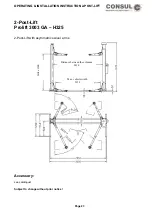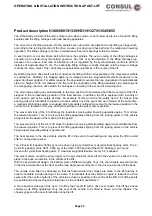
OPERATING & INSTALLATION INSTRUCTION 2-POST-LIFT
Product description H300/H301/H339/H331/H327/H354/H355
The lift basically consists of the main column and a slave column. In both columns are to be found the lifting
spindles and the lifting carriages with load bearing apparatus.
The drive turns the lifting spindle. On the spindles are nuts which are attached to the lifting carriage which,
according to the turning direction of the drive, moves up or down and thus performs the raising and lowering
operation. The lifting carriage is borne on maintenance free roller bearings within the column.
In each column is a motor driven belt which turns the spindles. The even running of the lifting carriages is
ensured via an electronic synchronizing governor. Any lack of synchronization in the lifting carriages (eg,
because of an uneven load, lack of lubrication, etc) is regulated by the synchronization control to within a
distance of approximately 10 cm. The advancing lifting carriage is briefly stopped until the slower carriage
reaches the same height. This check may be observed several times in the course of the lift.
By shifting the main drive switch at the control box the lifting motion corresponding to the movement symbols
is switched on. Similarly, it is stopped again by its release and via a programmable electronic device in the
upper and lower position. For safety reasons, the downward movement can be programmed to automatically
stop at a height of 200 mm (between the floor and the underside of the lifting apparatus). By releasing and
the reengaging, the main drive switch the carriages on lowering to the sound of a warning tone.
The main drive switch goes automatically to the stop position when released and the movement of the lift is
stopped in the corresponding position of the load bearers. In addition, the lift is equipped with a variety of
both passive and active safety devices. An example of this would be the safety device for broken load
bearing nuts which transfers the load to a reserve safety nut in the event of a worn thread. At the same time,
a mechanical blocking system is engaged which prevents continued movement to the lowered position in the
event of worn threads. In this way, unintentional travel on the safety nuts is avoided.
The swivel arm lock of the 6 to lift stops the load arms moving after travelling upwards approx. 15 mm from
the lowered position. This is to prevent the lifting apparatus slipping from the jacking points on the vehicle
being raised. Be aware of the meshing of the gears!
The swivel arm lock of the 3-4 to lift stops the load arms moving after travelling upward a short distance from
the lowered position. This is to prevent the lifting apparatus slipping from the jacking points on the vehicle
being raised. Operating safety is paramount!
The heat sensors in the drive motors stop the lift in the event of overheating and only allow the lift to restart
after a cooling down period.
The 2-Post-Lift (capacity 3000 kg) can be driven using symmetrical or asymmetrical bearing arms. The 2-
Post-Lift (capacity of the H301: 3500 kg, of the H327: 4000 kg and of the H331: 6000 kg) can only be
driven with symmetrical bearing arms. A maximum weight distribution of only 3:2 is allowed.
The swivel armes are all the same lenght on the symmetrical 2-Post-Lift and the vehicle to be lifted is to be
place in the drive-on direction in the middle of the lifts.
With the asymmetrical design, the bearing arms of different lengths. Thus, the short double swivel arms are
in the drive-on direction at the front and the long single swivel arms are in the drive-on direction at the back.
The vehicle to be lifted is positioned so that the forward-most door hinges are close to the lift columns in
order to facilitate a wide opening of the doors. It is desirable that the vehicle’s engine is towards the short
swivel arm (the centre of gravity of the vehicle as close as possible to the centre of the lift)!. All 4 lifting points
are positioned at the jacking points laid down by the vehicle manufacturer!
A more advanced design of the up to 3 to lift is the 2-post-Lift with a drive over chasis. This lift has a fixed
chassis as its lifting apparatus. Only one axel of the vehicle to be lifted is driven onto the chassis. The
chassis grips onto the door thresholds during the lift.
Page 24
Содержание 2.25 EMC
Страница 66: ...OPERATING INSTALLATION INSTRUCTION 2 POST LIFT Electric diagram for chain lifts H264 H265 Page 66 ...
Страница 67: ...OPERATING INSTALLATION INSTRUCTION 2 POST LIFT Electric diagram H342 Page 67 ...
Страница 68: ...OPERATING INSTALLATION INSTRUCTION 2 POST LIFT Electric diagram H325 Page 68 ...
Страница 69: ...OPERATING INSTALLATION INSTRUCTION 2 POST LIFT Electric diagram with rotary reversing switch Page 69 ...
Страница 70: ...OPERATING INSTALLATION INSTRUCTION 2 POST LIFT Electric diagram with push button Page 70 ...
Страница 71: ...OPERATING INSTALLATION INSTRUCTION 2 POST LIFT Page 71 ...
Страница 72: ...OPERATING INSTALLATION INSTRUCTION 2 POST LIFT Page 72 ...
Страница 73: ...OPERATING INSTALLATION INSTRUCTION 2 POST LIFT Page 73 ...
Страница 74: ...OPERATING INSTALLATION INSTRUCTION 2 POST LIFT Page 74 ...
Страница 75: ...OPERATING INSTALLATION INSTRUCTION 2 POST LIFT Page 75 ...
Страница 76: ...OPERATING INSTALLATION INSTRUCTION 2 POST LIFT Page 76 ...
Страница 77: ...OPERATING INSTALLATION INSTRUCTION 2 POST LIFT Page 77 ...
Страница 78: ...OPERATING INSTALLATION INSTRUCTION 2 POST LIFT Page 78 ...
Страница 79: ...OPERATING INSTALLATION INSTRUCTION 2 POST LIFT Page 79 ...
Страница 80: ...OPERATING INSTALLATION INSTRUCTION 2 POST LIFT Page 80 ...
















































